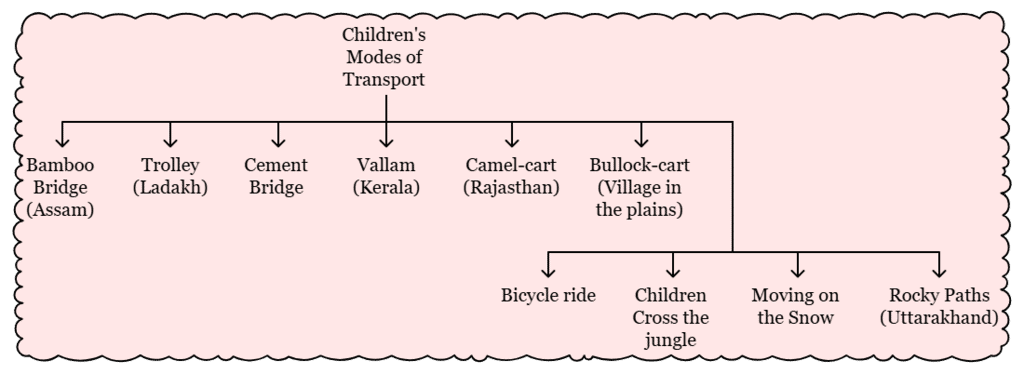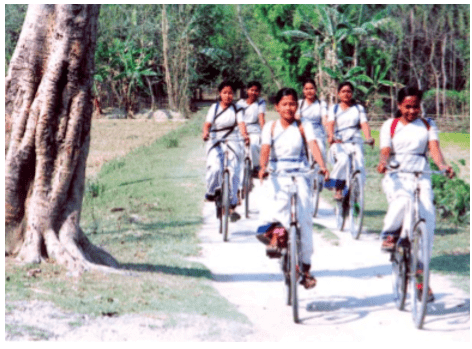Going to School Class 4 Notes EVS Chapter 1

The chapter "Going to School," shows how kids from various places travel to school in different ways. Some children use a bamboo ridge, a trolley, a cement bridge, a vallam (a type of boat), a camel cart, a bullock cart, or a bicycle. They travel through jungles, snowy areas, and rocky paths to get to school. It doesn't matter if they have to pass through dense forests, farmlands, or mountains; they still manage to reach school.

Children in our country go to school in a lot of different ways as mentioned below.
1. Bamboo Bridge (Assam)
In certain places, kids have to walk over tricky bamboo bridges that are narrow and need careful balancing to cross without any accidents. This shows that these children live in areas with lots of trees or steep land where bamboo bridges are built because there aren't any other ways to cross safely.

It rains very much in some areas such as Assam. Sometimes after the rain, there is knee-high water everywhere. Children use the Bamboo Bridge to go to school.They hold the books in one hand and bamboo in the other and quickly cross the bamboo and rope bridge to reach school.
2. Trolley (Ladakh)
In Ladakh, children must cross a river to reach school. To facilitate this crossing, a sturdy iron rope is securely fastened across the wide and deep river, anchored to robust trees or rocks. Children utilize a trolley capable of carrying five to six individuals to travel to the school located on the opposite bank the river.
To cross the wide and deep river to get to school Children use Trolley in Ladakh.
There is a strong iron rope across the river. On both the sides it is tied tightly with strong trees or rocks. There is a trolley (an open box made of wood) attached with the rope.
3. Cement Bridge
Children often use bridges to cross over water, taking advantage of structures built using materials like cement, bricks, and iron rods. Some bridges may include steps to make crossing easier.
Differences between a Cement Bridge and a Bamboo Bridge
- Cement bridge is made of cement, bricks and iron rods. On the other hand, a bamboo bridge is made of bamboo sticks and ropes.
- Cement bridge is much stronger than the bamboo bridge.
- Cement bridge can bear the weight of heavy vehicles like trucks, buses, etc. whereas a bamboo bridge cannot bear heavy weight

4. Vallam (Kerala)
Children in the state of Kerala use a small wooden boat known as a vallam as a means of transportation to get to school.

5. Camel-cart (Rajasthan)
Children in Rajasthan live in the heart of the desert where sand dominates the landscape, and daytime temperatures soar. To reach school, they utilize camel carts for transportation.

Sand is all around in the desert in Rajasthan. It also gets very hot in the day. Children ride in a camel-cart to reach school.
6. Bullock-cart (Village in the plains)
Kids from villages with flat lands go to school in bullock carts. They travel slowly across green fields in the cart. If it's very hot or rainy, they use umbrellas.

In villages in the plains, children ride bullock-cart. It goes slowly through the green fields. Some of the bullock carts have roofs but mostly they are without roofs. If it is too sunny or raining, children use umbrellas.
7. Bicycle ride
Some children ride bicycles on the long road to school. At first, girls here did not go to school, because it was too far. But now groups of 7-8 girls easily ride even through the difficult roads.

8. Children Cross the jungle
Kids who live in forests have to walk through the jungle to go to school. In some parts, the trees are so thick that sunlight can't come through. It's very quiet in the jungle, and you can only hear the sounds of birds and other animals.

9. Moving on the Snow
Children living in the Northern hills often have to walk long distances to reach school, especially when there is snow. They walk together, holding hands, and proceed cautiously. If the snow is soft, their feet might sink in, and they might slip and fall on solid snow.

In the Northern Hills, children go to school through miles of snow. They hold hands and walk carefully.
If the snow is soft, their feet sink into it. When the snow is frozen, they may slip and fall, so they have to stay careful.
10 Rocky Paths (Uttarakhand)
In Uttarakhand, the area is full of big mountains where children live. The ground is bumpy and not smooth, which might be hard for kids used to living in flat places. But these kids can climb up and down the hills quickly to get to school.

But no matter whether there is a dense forest, farms, mountains or snow on the way, children manage to reach school.
|
49 videos|217 docs|54 tests
|
FAQs on Going to School Class 4 Notes EVS Chapter 1
| 1. What are some unique ways children in India travel to school? |  |
| 2. How do children cross difficult terrains to reach school? |  |
| 3. What role does a bicycle play in the daily commute of school children? |  |
| 4. How do traditional transport methods impact the daily lives of children in rural areas? |  |
| 5. Why is it important to understand the different modes of transport used by children in India? |  |

















